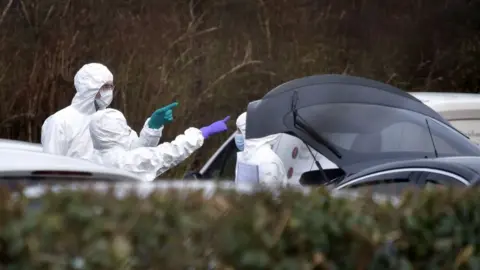Omagh police shooting: John Caldwell attack causes shockwaves in PSNI
 Google
GoogleUnlike previous chief constables, Simon Byrne, until Wednesday night, had never taken a phone call like it.
It was news that John Caldwell - one of his top investigators - was fighting for his life.
At a press conference the next day, he spoke of it being a deeply troubling day for an organisation which had suffered so much in the past.
Behind him were memorial gardens honouring more than 300 officers murdered in decades gone by.
The shooting of Det Ch Insp Caldwell sent a shockwave through the Police Service of Northern Ireland (PSNI) and the wider community.
Based on the New IRA being named by the police as having been responsible, it is arguably the most significant dissident republican attack in Northern Ireland for many years.
There is a feeling this was the attempted assassination of a major target - a "relentless investigator" in the words of a former colleague Chris Noble, now the chief constable of Staffordshire Police.
Multiple investigations had brought the 48-year-old detective face-to-face with suspected killers in both organised crime gangs and terrorist groups.
But it was the New IRA who sent two gunmen to ambush him off-duty in front of his son at a training session for young footballers.
Someone who worked alongside him said: "Undoubtedly he was a bigger target because of who he was."
He lived under several threat warnings, one of which is being linked to his inquiries into the unsolved murder of PSNI officer Ronan Kerr, 25, by a dissident undercar bomb in Omagh in 2011.
 PSNI
PSNIOn the 10th anniversary of the constable's killing, Det Ch Insp Caldwell was the public face of a fresh PSNI appeal for information and a determination to bring justice.
In the same County Tyrone town last Wednesday, he came very close to becoming the first police officer murdered since Mr Kerr.
The attack appears to underscore, in brutal fashion, the re-emergence on the New IRA after nearly four years of surface level inactivity.
In 2019, it shot dead journalist Lyra McKee as she watched rioting unfold in Londonderry.
Within a year, its suspected leadership was rounded-up by the PSNI following a surveillance operation run by MI5 using an alleged agent.
Ten individuals are currently awaiting trial on almost 50 terrorism charges as a result of Operation Arbacia.
In the aftermath, the New IRA was viewed as being in complete disarray and the main narrative pushed in policing and security circles was that the threat it posed had been severally blunted.
As a consequence last year, for the first time in more than a decade, the government announced the threat level in Northern Ireland was being lowered from severe to substantial.
It might not have sounded much - the risk of attack went down from highly likely to likely - but it was a hugely symbolic moment.
Attacks, or attempted attacks, dropped markedly: the years 2020-22 saw a virtual absence of activity.
But the New IRA was reorganising and in November it mounted a roadside bomb attack, using military grade explosives, on a police patrol car in Strabane.
The armour-plated vehicle did its job and two officers inside escaped injury.
The attack has now been followed up with the attempted murder, fewer than 20 miles away, of Det Ch Insp Caldwell.
 Pacemaker
PacemakerSo what can be drawn from these events?
Firstly, the New IRA had been disrupted but not crushed.
It does, however, remain a small organisation with insignificant support, albeit one which is once again demonstrating an intermittent ability to carry out acts of violence.
It has nothing remotely near the capacity of its predecessor, the Provisional IRA.
MI5 recordings from the Operation Arbacia case reveal the New IRA as having been desperate to acquire weaponry.
Estimates of members have not been provided for dissemination for years.
But no-one has suggested they have drastically altered from what was briefed out in security circles at that point - perhaps up to 100 people prepared to directly engage in acts of terrorism.
It is scattered operationally around Derry, Strabane and other parts of County Tyrone, and west Belfast.
The New IRA is the biggest and most active of the dissident groups which exist as opponents to the 1998 Northern Ireland peace settlement.
The Continuity IRA has largely been quiet since the discovery of a bomb attached to a lorry trailer intended to cause "a Brexit attack" on a cross-channel ferry, or at Belfast docks, in early 2020.
The other currently active organisation is Arm na Poblachta, which late in 2022 forced a delivery driver at gunpoint to transport a small bomb to Waterside police station in Derry.
There is some sense that dissident groups could be trying to gain momentum with Stormont down and politics being portrayed as failing.
There is also the approaching 25th anniversary of the Good Friday Agreement, which dissidents see as a capitulation by the republican mainstream to continued partition of the island of Ireland into the Republic of Ireland and Northern Ireland.
All this will be occupying the minds of the PSNI and MI5 - which has assumed the lead role in intelligence gathering since 2007.
For PSNI officers, the shooting of one its most high-profile detectives will serve as a wake up call in terms of personal security.
The vast majority of its 6,700 officers never served in the Royal Ulster Constabulary during the Troubles and are now being urged to be more vigilant than at any point recently.
The security developments arrive at a difficult time for the PSNI.
It is not replacing 300 officers who left over the past 12 months due to budget problems and it is potentially looking at further significant cutbacks in the years ahead.
Already at its lowest numbers since its formation two decades ago, it could shrink to around 6,000 officers by 2025.
This will play out politically in coming days and weeks, with the organisation asking can it contend with a reinvigorated dissident threat with diminished manpower and resources?
